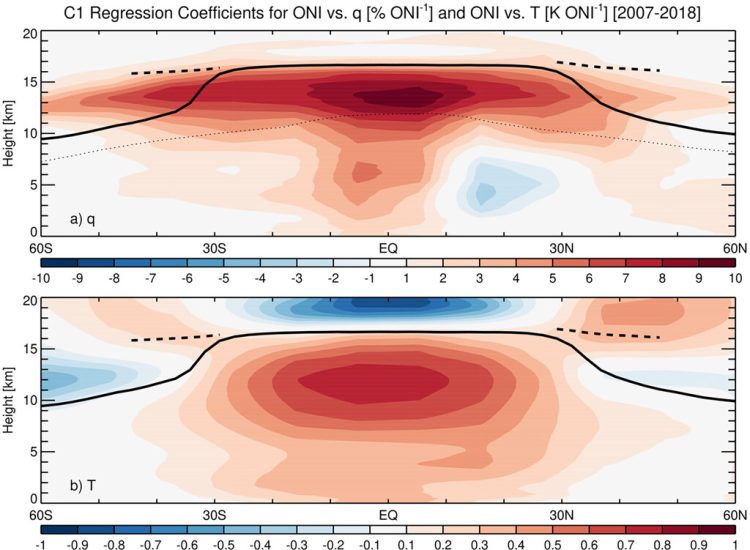
Research Interests
GNSS Radio Occultation data evaluation.
Tropical cyclone forecast improvement.
Tropical/extratropical deep convection.
Climate variability.
Upper troposphere/lower stratosphere dynamics.
Benjamin Johnston, Ph.D.
Project Scientist, UCAR, Hurricane Research Division
786.671.2453
3450 Mitchell Ln
Boulder, CO 80301

“This graphic shows latitude–height cross sections of regression coefficients between the Oceanic Niño Index (ONI) and zonal mean C1 (a) specific humidity and (b) temperature. Units are % per normalized ONI for specific humidity and K per normalized ONI for temperature. Regression coefficients are calculated with the ONI time series leading by 2 months. Tropopause heights are denoted by the solid black line and double tropopause heights are denoted by the dashed black line. The thin dotted line in (a) is approximately the level at which the moisture information content is almost exclusively from the a priori.”
Dr. Benjamin Johnston’s recent work demonstrates the impact that the assimilation of COSMIC-2 GNSS-Radio Occultation (RO) bending angle profiles has on tropical cyclone track and intensity forecasts in the Hurricane Weather Research and Forecasting (HWRF) model. In this study, they focused on the 2020 Atlantic hurricane season, which was the most active Atlantic season on record, and selected eight cases for study from tropical cyclones that reached hurricane strength and impacted land. The results showed that the assimilation of COSMIC-2 observations in HWRF can both improve and degrade TC track, intensity, and size forecasts. However, the mixed results were not surprising considering that no tuning was done to the data assimilation scheme.
His current work is focusing on using NOAA’s next-generation hurricane model, the Hurricane and Analysis Forecast System (HAFS), and tuning the RO data assimilation scheme in HAFS to maximize the impact of COSMIC-2 and commercial RO data sources on operational hurricane analyses and forecasts.
2019, Ph.D., Coastal and Marine System Science, Texas A&M University-Corpus Christi, Corpus Christi, TX
2012, M.S., Atmospheric Science, University of Maryland, College Park, MD
2009, B.S. Meteorology and Environmental Earth Science, California University of Pennsylvania, California, PA